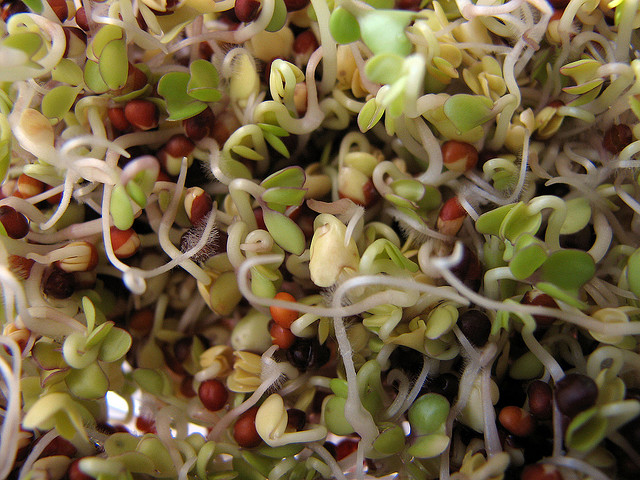Haven’t you eaten sprouts yet? Too bad – sprouts make a wonderful food. Their benefits have been known for ages, as they have a high nutritional value and they are easy to digest. By eating sprouts, we benefit from all the concentrated nutrients that the plant would use for its own growth. And, not negligibly, besides being healthy, sprouts taste delicious as well.

During the winter when our diet may not contain so many vitamins, it is essentially important to eat sprouts, but we shouldn’t neglect them in the summer either. However, if we try to buy them at stores, we’ll find that they cost a lot; besides, we don’t know where they originate from and how fresh they are. Also, due to factors related to their growth and transportation, they may be microbiologically contaminated.
The solution to all these problems is much simpler and cheaper than you would think. By investing a small sum, you will soon be able to grow excellent quality sprouts at home.
The procedure
Buy seeds suitable for sprouting. Such seeds are available at organic stores and, sometimes, in larger grocery stores. The most popular seeds for sprouting are beans, peas, broccoli, wheat, alfalfa, radishes, soy beans, red onions, red clover and mung beans. The sprouts of these seeds have various benefits, but they are all beneficial because of their high vitamin and mineral content. Their tastes also vary from neutral to bolder or even slightly hot.
This time, we bought a package of radish seeds from the local organic store. Not surprisingly, the taste of the sprouts will remind one to that of radishes, except they taste a bit hotter. If you like radishes, you will sure like the sprouts too.
What you will need besides the seeds
- a plastic bowl
- a strainer
- some water
Prepare the seeds.
Most seeds need to be soaked first. Usually it is written on the bag how many hours of soaking they will need; this time may range from several hours to a few days. Radish seeds should be soaked for about 8 hours.
Important! Don’t use up all the seeds in the package at once. I usually use enough seeds to cover the bottom of the strainer in a single layer.
Start the procedure
You can use a transparent plastic bin you have poked holes into, or you can buy a sprouting dish. However, the simplest way is to use the strainer mentioned before, and a bowl. Make sure there is a single layer of seeds in the strainer, as they may turn mouldy if they cover each other. Place the strainer above the bowl filled with water, without letting the water touch the seeds. This way, the evaporating water will keep the seeds moist; they won’t dry out, but they won’t sit in water either.
Place the bowl on the kitchen table or a counter; it doesn’t need to be put in the fridge or in a dark place. If it catches bright sun during the day, cover it with a plastic plate for the sunny hours, so the moisture won’t evaporate.
Here’s the simple, cheap strainer I have mentioned. A regular plastic bowl can be placed underneath it; I just happened to use a measuring cup this time.
From time to time, rinse the growing sprouts. It would be the best to do this twice a day, in the morning and in the evening, by simply placing the strainer under the tap. This way the greens will be refreshed and they won’t turn mouldy.
The harvest
The total time for growing the sprouts is indicated on the package – usually it takes about 3-4 days for radish sprouts to reach their optimal size. Enjoy them!
How much sprouts will you need?
We usually sprout a strainer full of seeds at a time. This way, a package of seeds will be enough for 10-12 times. With very little money, we obtain a healthy and delicious food.
Sprouts of various seeds all look a bit different, and their sizes vary too. After growing them for a while, you will be able to recognize each kind easily.
